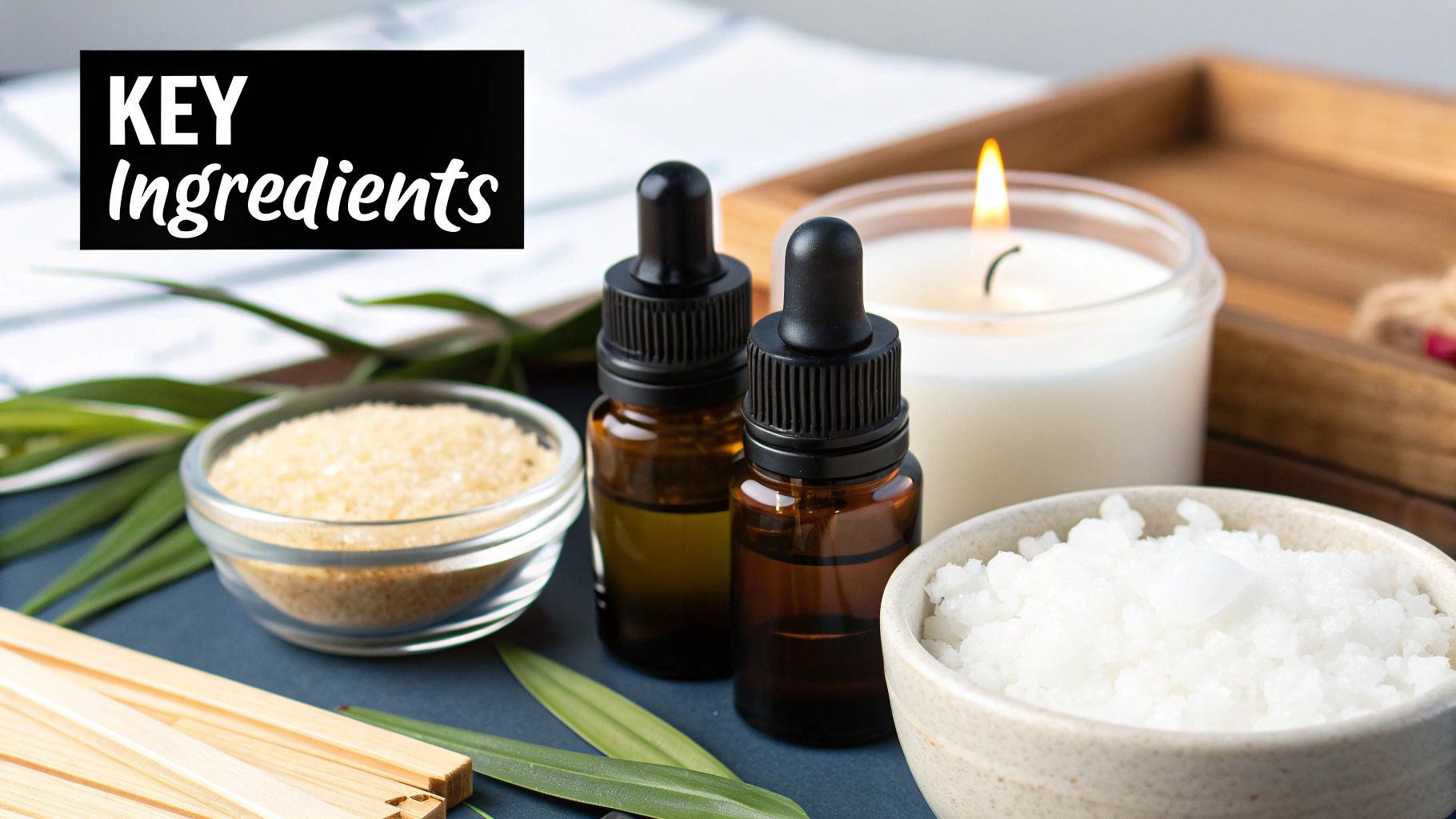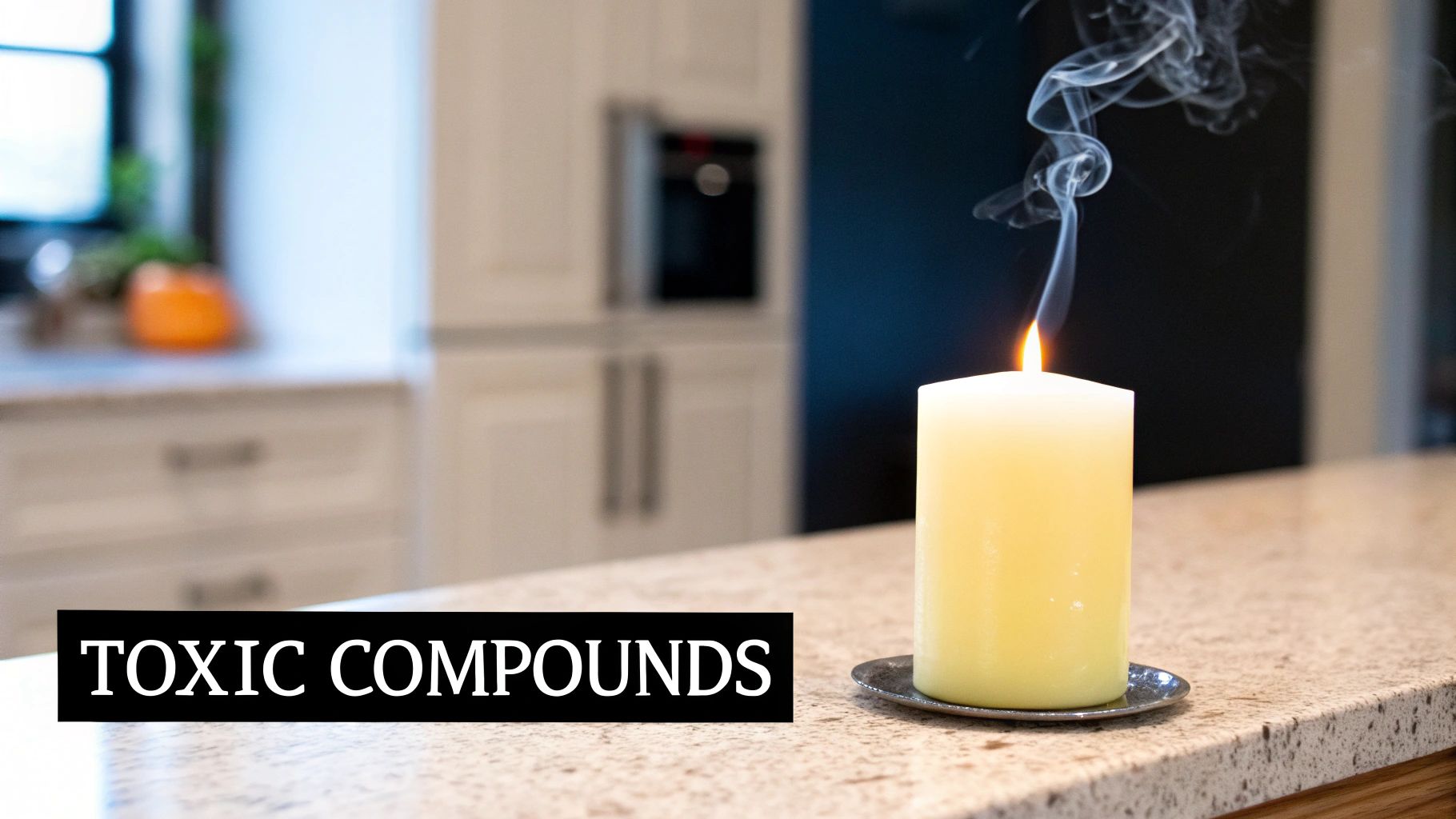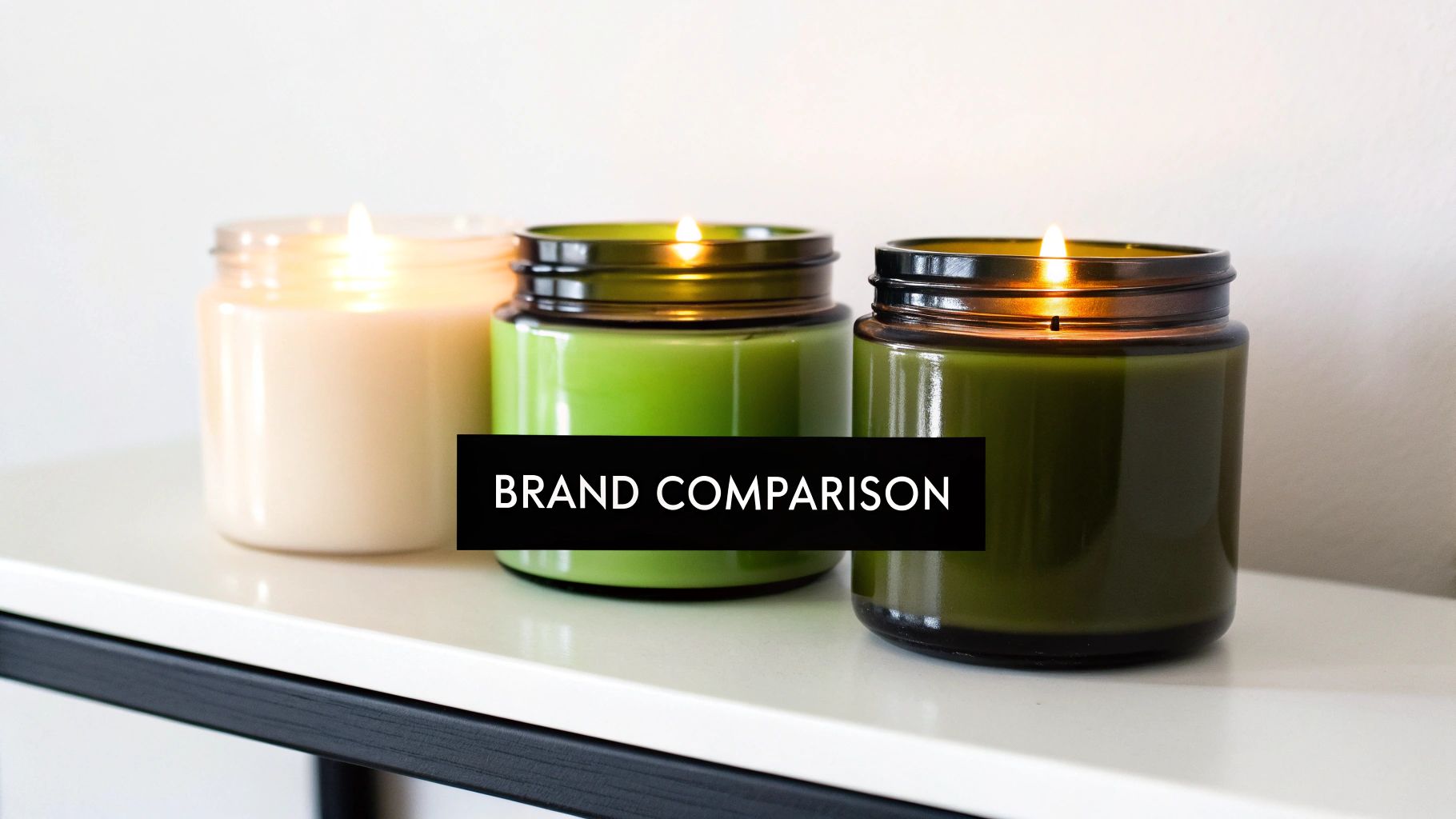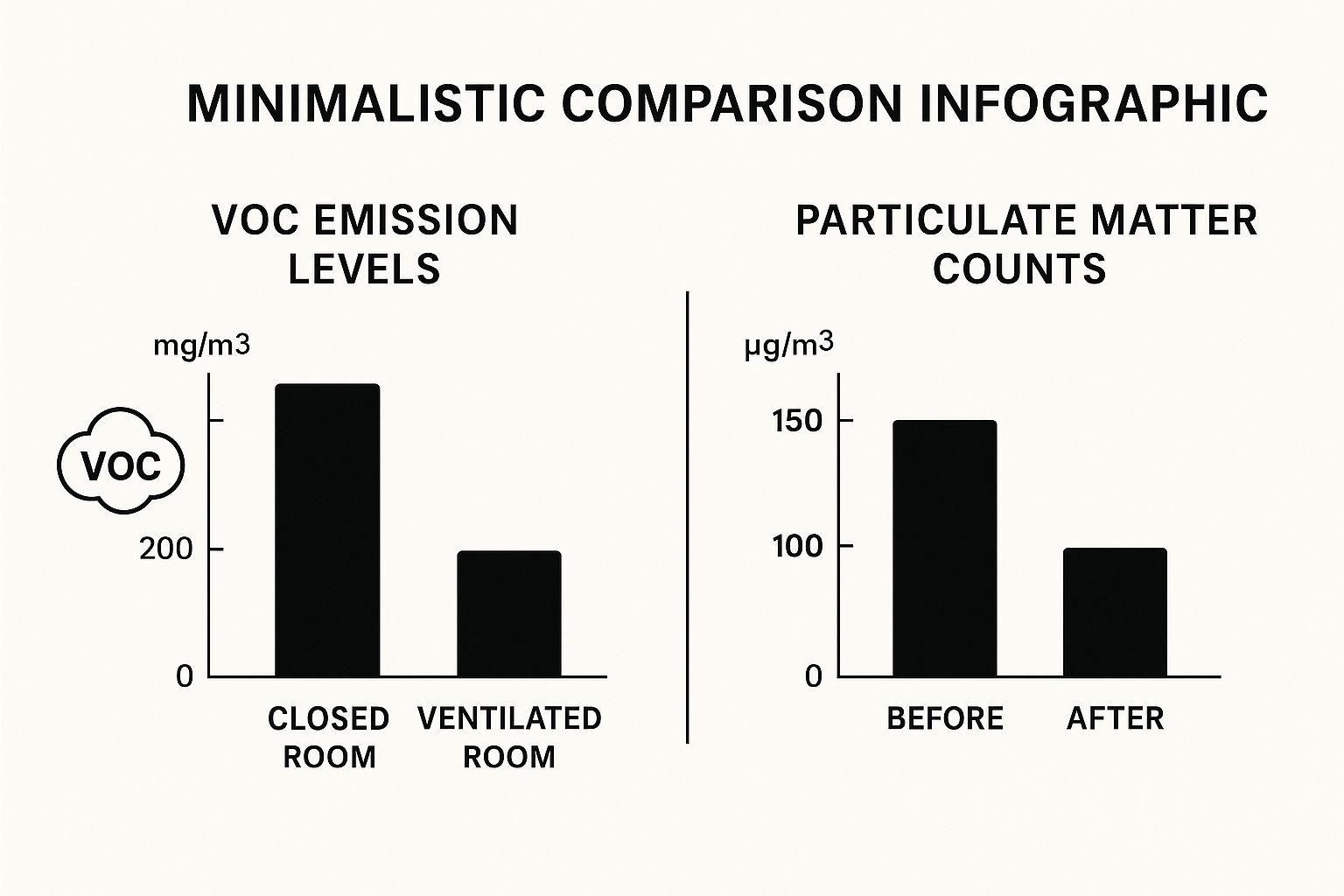It's a question I hear all the time: are my favourite Bath & Body Works candles actually bad for me? The short answer is, they aren't going to cause immediate, serious harm. But that doesn't mean there aren't valid reasons to be concerned.
The real issue lies with their core ingredients – paraffin wax and synthetic fragrances – which can release certain pollutants into your home when you light them. For people who are a bit more sensitive, this could mean anything from a nagging headache to a full-blown allergy flare-up.
The Burning Question About Bath and Body Works Candles
You love those unmistakable scents, but a little voice in your head is wondering what you're really breathing in. Instead of looking for a simple 'yes' or 'no' answer, it's more helpful to look at the bigger picture. We need to consider the ingredients, how you burn your candles, and, most importantly, the ventilation in your space.
Here’s a helpful analogy: you'd never leave a car running in a closed garage because the fumes would build up to dangerous levels. While a candle is nowhere near as potent, burning one in a small, poorly ventilated room creates a similar, albeit much slower, effect. It's this gradual accumulation of pollutants that we need to think about.
Key Ingredients of Concern
The heart of the debate really comes down to a few specific components that you'll find in most of their candles:
- Paraffin Wax: This is a byproduct of petroleum. When you burn it, paraffin wax can release a variety of volatile organic compounds (VOCs), such as benzene and toluene, into the air.
- Synthetic Fragrances: These are complex, man-made chemical concoctions that create those powerful scents we know and love. Unfortunately, they can also release their own set of VOCs and potential allergens.
- Wicks: While lead-core wicks were banned years ago, the material and construction of the wick still play a big role in how cleanly a candle burns and how much soot it kicks up.
Below is a quick rundown of the main concerns people have.
Key Concerns at a Glance
| Concern | Primary Cause | Potential Effect |
|---|---|---|
| Indoor Air Pollution | Paraffin wax burning | Releases VOCs like toluene and benzene. |
| Allergic Reactions | Synthetic fragrance oils | Can trigger headaches, sneezing, or respiratory irritation. |
| Soot Production | Inefficiently burning wicks & paraffin | Black soot can stain surfaces and be inhaled. |
These potential issues are why it’s so important to be an informed consumer.
The fact is, Bath & Body Works candles are primarily made from paraffin wax. Independent environmental reports have shown that emissions from this type of wax can negatively impact indoor air quality—a particularly significant issue in places like California where air quality standards are a major focus.
It's not just about what's in the candle wax, but what gets released into the air when you light it. To get a better handle on what makes some candles a healthier choice, take a look at our guide on clean-burning candles.
What's Really Inside Your Favourite Candle?

To figure out if Bath & Body Works candles are safe, we need to look past the pretty jars and catchy scent names. It helps to think of a candle as a simple recipe with three main parts: the wax (the fuel), the wick (the delivery system), and the fragrance (the main event).
What each of these is made of determines exactly what gets released into your home's air. It's the difference between a clean, nourishing meal and one packed with artificial additives you can't pronounce.
The Foundation: The Candle Wax
Most candles from Bath & Body Works are made with paraffin wax. This is a big deal because paraffin is a byproduct of the petroleum industry—the same industry that produces gasoline and crude oil. It’s cheap and fantastic at holding a strong scent, but its source is a major red flag for many.
When paraffin wax burns, it can release volatile organic compounds (VOCs) like toluene and benzene, which are also found in things like paint thinner and car exhaust. This is a stark contrast to natural waxes that offer a much cleaner burn.
- Soy Wax: A fantastic alternative made from soybeans. It's renewable, biodegradable, burns slower, and creates far less soot.
- Beeswax: A completely natural gift from honeybees. Beeswax candles are famous for their clean burn and are even said to help purify the air.
The type of wax used is arguably the most important factor for a candle's health impact. Even though paraffin is an industry staple for its low cost and strong scent throw, you are essentially burning a fossil fuel product inside your living room.
The Delivery System: The Wick
A wick's job is simple: draw melted wax up into the flame so it can burn. Thankfully, lead-core wicks were banned in Canada years ago due to their clear health risks. But the wick material still matters.
Most good candles today use either cotton or wood wicks. The real issue arises from poor construction or improper care. If you don't trim the wick, the flame can get too big and flicker wildly, leading to incomplete combustion. This process creates more smoke and fine particulate matter (soot) that can easily irritate your lungs.
The Main Attraction: The Fragrance
Here’s where things get a bit murky. Those incredibly strong, memorable scents aren't coming from pure essential oils. They are created with synthetic fragrance oils, which are complex cocktails of chemicals mixed together in a lab to imitate a specific smell.
The problem? The single word "fragrance" on a label can hide dozens, sometimes hundreds, of undisclosed chemicals. Some of these can be known allergens or respiratory irritants. To really get a handle on this, learning more about the differences between fragrance oils and essential oils can give you the knowledge you need to choose what you bring into your personal space.
How Scented Candles Can Affect Your Health

It's actually pretty simple to connect the dots between what's in a candle and how you feel. When you light up a candle made from paraffin wax and synthetic fragrances, it pumps a cocktail of volatile organic compounds (VOCs) and fine soot particles straight into the air you breathe.
Think of your home's air like a clear glass of water. Every time you burn a paraffin candle, it’s like adding a few drops of mud. A single candle might not seem like a big deal, but over time, that water gets murky. That’s exactly what’s happening to your indoor air quality.
This gradual pollution can trigger some very real physical symptoms. Many people start to notice things like:
- Headaches and dizziness
- Watery, irritated eyes
- A scratchy or sore throat
- Flare-ups of allergies or sinus problems
If you have asthma, chemical sensitivities, or other respiratory issues, the reaction can be much faster and more severe. These individuals are often the "canary in the coal mine," picking up on poor air quality long before anyone else does.
The Science Behind the Symptoms
These symptoms aren't just in your head; they're your body's direct response to the irritants floating around. Research backs this up, showing that burning paraffin-based scented candles can seriously pollute the air inside our homes.
One study found that burning these types of candles can cause indoor concentrations of VOCs and particulate matter to spike by up to 20-30% above normal levels. Many of these VOCs are phthalates, which are known endocrine disruptors that can mess with hormonal balance after long-term exposure.
This is a big deal, especially when you consider public health reports from places like California, which estimate that over 2 million adults live with chronic respiratory conditions that are made worse by poor indoor air.
It helps to understand the bigger picture of your home's air, as many different things can affect what you're breathing day in and day out. You can learn more about indoor air quality to get a full overview.
And if you’re curious about how much of a difference the wax makes, our article on https://shivoracandles.com/blogs/news/are-soy-candles-non-toxic breaks it all down.
What the Official Safety Data Sheets Reveal

If we want to get past the online chatter and really understand the risks, the best place to look is the official documentation. Think of a Safety Data Sheet (SDS) as a product's official report card. It's a document that manufacturers are required to create, breaking down a chemical product's components and potential hazards for both consumers and workers.
Looking at the SDS for Bath & Body Works candles, you’ll see they are compliant with major safety regulations. For example, they don’t list ingredients known to be carcinogens under strict laws like California's Proposition 65. But that’s not the whole story. These same documents openly acknowledge that the candles contain known irritants.
Reading Between the Lines
The SDS for many of their candles is pretty clear-cut. It flags the product as flammable and carries warnings like "may cause an allergic skin reaction" or could lead to skin and eye irritation. This is a direct confirmation that some chemicals in their fragrance blends are potent enough to trigger a physical reaction in people with sensitivities.
You can learn more about what goes into these fragrance oils by checking out our guide to phthalate-free fragrances.
Another big clue about the candle’s chemical makeup comes from the environmental warnings.
The Safety Data Sheets for some Bath & Body Works candles state that certain ingredients are "very toxic to aquatic life with long-lasting effects." While this warning is about environmental disposal, it speaks volumes about the powerful, synthetic nature of the compounds inside the jar.
So, what does this all mean for you? It doesn't mean lighting one of these candles is immediately dangerous. Instead, it gives you an evidence-based way to evaluate what you're bringing into your home.
These official documents confirm that while the candles meet the legal definition of "safe," they are made with potent synthetic chemicals. This is something to be mindful of, especially if you have allergies, sensitivities, or simply prefer cleaner, more natural products in your space.
Choosing Safer Candles for a Healthier Home
Deciding to move away from candles with questionable ingredients doesn't mean your home has to be fragrance-free. Think of it as simply upgrading your choices to better match a healthier lifestyle. The great news is there are plenty of amazing, cleaner-burning alternatives that fill your space with beautiful scents, minus the worry.
Making a more conscious choice starts with knowing what to look for on the label. When you're shopping, keep your focus on candles made from 100% natural waxes, and steer clear of paraffin or vague "paraffin blends."
Finding a Cleaner Burn
The best alternatives come straight from nature, and each one brings something unique to the table.
- Soy Wax: A fantastic plant-based option made from soybeans. It's a renewable resource that burns slower and cleaner than paraffin, which means less soot floating around your home.
- Beeswax: This is a classic for a reason. Not only does beeswax burn cleanly, but some believe it also acts as a natural air purifier by releasing negative ions that help neutralize pollutants in the air.
- Coconut Wax: Known for its fantastic ability to carry a scent and provide a long, even burn, coconut wax is another sustainable, plant-based choice for a healthier home.
To help you sort through the options, here’s a quick comparison of the most common waxes you'll find.
Comparing Candle Wax Types
| Wax Type | Source | Key Benefits | Potential Downsides |
|---|---|---|---|
| Soy Wax | Soybeans | Renewable, clean burn, less soot, slower burn time. | Softer wax, may not hold as much fragrance as paraffin. |
| Beeswax | Honeycomb | Natural, clean burn, may help purify the air, long-lasting. | More expensive, has a subtle natural honey scent. |
| Coconut Wax | Coconuts | Sustainable, excellent scent throw, clean, even burn. | Often blended with other waxes, can be pricier. |
| Paraffin Wax | Petroleum | Inexpensive, holds strong fragrance, widely available. | Non-renewable, releases soot and potential toxins. |
Ultimately, choosing a wax like soy, beeswax, or coconut is a fantastic step towards a cleaner burn.
Even with the best candles, a little fresh air goes a long way. The image below shows just how much simple ventilation can reduce the level of pollutants from any candle you burn.

As you can see, just cracking a window open can dramatically improve your indoor air quality while you enjoy your favourite scent. It's a simple habit that makes a big difference.
What to Look for on the Label
Beyond the wax itself, you'll want to check the wick and the fragrance source. Always look for candles that use lead-free cotton or wood wicks, as they provide a cleaner, more stable flame.
When it comes to the scent, your best bet is to find products fragranced with pure essential oils or high-quality, phthalate-free fragrance oils. If you’re ready to make the switch, this guide to the best non-toxic candles for a cleaner burn is a great place to start.
The bottom line is to read your labels carefully. Ambiguous terms like "wax blend" can often be a sneaky way of including paraffin, so search for explicit phrasing like "100% soy wax" or "100% beeswax" to be sure you're getting a genuinely natural product.
Best Practices for Burning Any Candle Safely
What a candle is made of is only half the story. How you actually burn it plays a massive role in what you end up breathing in. Whether you've got a paraffin candle or a natural soy one, a few simple habits can make a world of difference, dramatically cutting down on airborne particles and giving you a much better experience.
The single most important thing you can do? Ensure proper ventilation. Always light your candles in a room with decent airflow—cracking a window is perfect. This one small step stops soot and other emissions from building up, keeping your air fresh. Think of it as a non-negotiable for a clean, safe burn.
Smart Burning Habits
Beyond getting some fresh air circulating, a couple of other key practices will help you get the most out of any candle. Following these tips helps keep smoke to a minimum and ensures your candle burns down evenly and lasts as long as it should.
- Trim That Wick: Before you light it—every single time—trim the wick down to about 1/4 inch. A long wick creates a giant flame, and that’s what causes all that ugly black soot to form on your jar and float into the air.
- Know When to Blow It Out: As a rule of thumb, never let a candle burn for more than four hours straight. Burning it for too long can cause the container to get dangerously hot and the wax pool to get too deep, which might make the wick mushroom or droop.
Your burning habits have a direct impact on indoor air quality. By trimming the wick and ensuring good airflow, you are actively minimizing the release of particulate matter, regardless of the candle's wax type.
For a deeper dive, check out our full guide on the top candle safety tips for a safe and cozy home. Taking these small precautions means you can relax and enjoy the warm, comforting glow of any candle with complete peace of mind.
Your Questions, Answered
Even after getting the lowdown on candle ingredients, you probably still have a few questions floating around. It's totally normal. Let's tackle some of the most common concerns people have when they're on the fence about Bath & Body Works candles.
Are 3-Wick Candles More Toxic?
They aren't "more toxic" by design, but they do release more of everything, and faster. Think of it like a bigger engine burning more fuel. A 3-wick candle burns through a lot more wax and fragrance oil than a single-wick candle does in the same amount of time.
The result is a higher concentration of VOCs and soot hitting your indoor air. This just means that good ventilation—like cracking a window—is even more important when you've got one of these big candles going.
Is the Black Soot From My Candle Dangerous?
That black stuff is called petro-soot, and it’s essentially fine particulate matter that you can breathe deep into your lungs. If you or someone in your family has asthma, allergies, or any respiratory issues, this soot can be a major irritant.
While a little bit of soot now and then isn't a huge deal for most healthy people, why not avoid it? You can cut down on soot dramatically by always trimming your wick to 1/4 inch before you light it and keeping the candle out of drafts.
Are Wall Plugins a Safer Alternative?
Not necessarily, and this surprises a lot of people. Many of the most popular wall plugins and room sprays use the exact same synthetic fragrance cocktails—phthalates and VOCs included—that you find in paraffin candles.
They don't create soot because there's no flame, but they do pump these chemicals into your air constantly. If you want a genuinely safer way to scent your home, an essential oil diffuser is a fantastic choice. It just uses water vapour to disperse pure, natural plant oils without any synthetic additives.
For a truly clean and luxurious fragrance experience, explore the hand-poured, soy wax collections from Shivora Candles. Discover your new favourite non-toxic scent today at https://shivoracandles.com.






